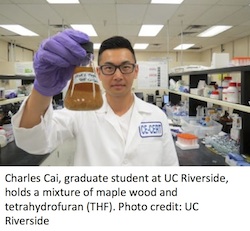University of California, Riverside researchers have developed a versatile, virtually non-toxic and efficient way to convert raw ag and forest residues along with other plant matter into biofuels and biochemicals. Professor Charles E. Wyman is leading the research team and their patent-pending method coined Co-solvent Enhanced Lignocellulosic Fractionation (CELF) and they believe they are another step closer to solving the goal of producing biofuels and biochemicals from biomass and high enough yields and low enough costs to become viable.
“Real estate is about location, location, location,” said Wyman, the Ford Motor Company Chair in Environmental Engineering at UC Riverside’s Center for Environmental Research and Technology (CE-CERT). “Successful commercialization of biofuels technology is about yield, yield, yield, and we obtained great yields with this novel technology.”
 The key to the technology, according to Wyman, is using tetrahydrofuran (THF) as a co-solvent to aid in the breakdown of raw biomass feedstocks to produce valuable primary and secondary fuel precursors at high yields at moderate temperatures. These fuel precursors can then be converted into ethanol, chemicals or drop-in fuels. Drop-in fuels have similar properties to conventional gasoline, jet, and diesel fuels and can be used without significant changes to vehicles or current transportation infrastructure.
The key to the technology, according to Wyman, is using tetrahydrofuran (THF) as a co-solvent to aid in the breakdown of raw biomass feedstocks to produce valuable primary and secondary fuel precursors at high yields at moderate temperatures. These fuel precursors can then be converted into ethanol, chemicals or drop-in fuels. Drop-in fuels have similar properties to conventional gasoline, jet, and diesel fuels and can be used without significant changes to vehicles or current transportation infrastructure.
Compared to other available biomass solvents, THF is well-suited for this application because it mixes homogenously with water, has a low boiling point (66 degrees Celsius) to allow for easy recovery, and can be regenerated as an end product of the process, explained Charles M. Cai, a Ph.D. student working with Wyman.
The research, focused on lignin, was recently published in Green Chemistry: “Coupling metal halides with a co-solvent to produce furfural and 5-HMF at high yields directly from lignocellulosic biomass as an integrated biofuels strategy.”

